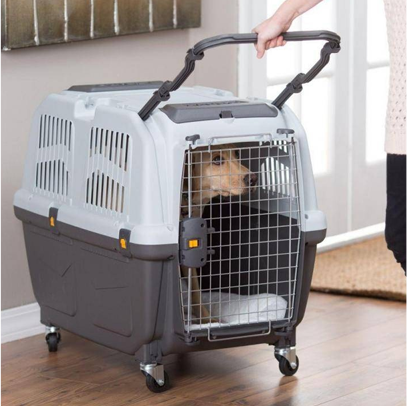Air travel with pets has become increasingly common in recent years, but it’s not as simple as booking a ticket and packing a carrier. Airlines follow strict international and domestic regulations when it comes to transporting animals. These rules directly influence the size, material, structure, and overall design of the pet carrying cage. Understanding these requirements is essential for both manufacturers and buyers seeking reliable and travel-approved options.
- The Role of IATA Standards
The International Air Transport Association (IATA) sets the global benchmark for live animal transportation. Carriers used for air travel must comply with these standards to be accepted by airlines. IATA guidelines influence several core design elements of a pet carrying cage:
Dimensions: The cage must be large enough for the pet to stand, sit, lie down, and turn around comfortably. If a cage is too small, the airline may reject it at check-in.
Structure: A sturdy, leak-proof base and rigid construction are required to protect the pet during transit.
Ventilation: Adequate openings on at least three sides allow for consistent airflow throughout the trip.
Security: The door must lock firmly and resist accidental openings. Many designs use spring-loaded or dual-side locking systems.
For manufacturers, creating a carrying cage that meets or exceeds IATA standards is no longer optional—it’s a market necessity.

- Airline-Specific Adjustments
Although IATA offers a global framework, individual airlines may apply their own additional rules. Some carriers, for instance, require reinforced frames or metal bolts instead of plastic clips. Others may limit the use of wheels or demand water containers that can be refilled from outside the cage.
Because of this, carrying cages designed for flight often include detachable wheels, feeding bowls, and handles to comply with various international carrier requirements. Many manufacturers now label cages as “airline-approved” based on these multilayered criteria, simplifying the purchasing decision for buyers.
- Size and Weight Considerations
The combined size and weight of the pet and cage influence whether they can travel in the cabin or must be checked into cargo. Cabin-approved carrying cages must typically fit under the airplane seat, which places limits on their size. This has led to a rise in compact, soft-sided carriers that still provide comfort and ventilation for smaller pets.
For cargo travel, hard-sided cages dominate. These cages are often built with reinforced corners, grip-friendly handles, and additional fastening options to prevent sliding or tipping during transport.
- The Impact on Product Development
As travel-related pet ownership increases, manufacturers must consider multiple layers of compliance when designing new carrying cages. Regulatory awareness is not just important for safety—it also affects product marketability. Cages that visibly follow IATA and airline-specific standards can give buyers more confidence, especially in B2B environments.
Moreover, product features like removable waste trays, metal mesh doors, and built-in labels for pet details are now common expectations. These features improve not only the travel experience but also logistics for airport staff and cargo handlers.
With the pet travel industry expected to grow steadily, we may see stricter regulations or new innovations like temperature monitoring systems or real-time travel tracking become standard. Designing with flexibility and adaptability in mind ensures that today’s carrying cage won’t be outdated tomorrow.


 English
English Español
Español Deutsch
Deutsch

